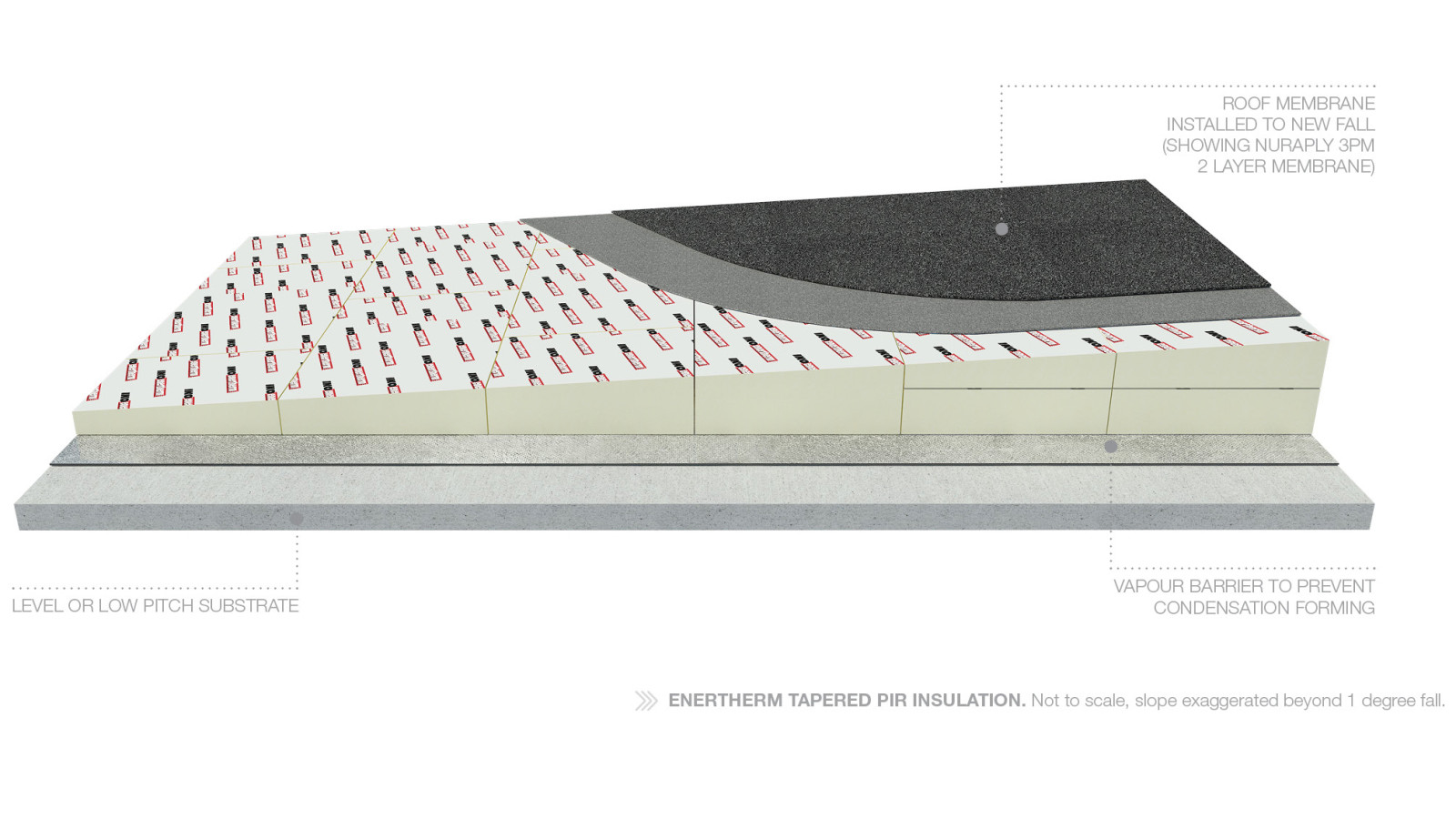New Zealand’s Building Code states that flat roofs are required to shed water effectively, with slope regulations depending on the roofing type. Metal roofing profiles, for instance, must have a minimum slope of three degrees, or five degrees depending on location, wind zone and profile selected. For flat roofs with membrane systems, creating effective drainage is essential to prevent water pooling and ensure durability.
Traditional methods of achieving roof falls include adjusting the roof structure itself by altering the height of supporting beams or using additional materials like screed layers. However, incorporating these falls with tapered insulation can simplify design and avoid structural modifications, making it a cost effective alternative.
Why choose tapered PIR insulation?
Tapered PIR insulation serves a dual function in flat roof systems, providing both thermal insulation and essential drainage. PIR’s closed-cell, rigid foam structure offers superior thermal resistance, moisture resistance, fire resistance, and compression strength.
By utilising a tapered warm roof system such as Nuraply, designers can introduce a precise gradient for water flow. Unlike traditional methods, which are often labour-intensive, and time-consuming, tapered PIR boards are manufactured with a consistent 1-degree angle and allow for easy installation. Therefore, reducing labour costs, materials, and installation costs.
Nuralite’s tapered Nuraply Warm Roof system includes four distinct board types — A, B, C, and D — each incrementally thicker, starting from a 40mm base thickness. This modular approach allows for flexibility in design, enabling efficient drainage across various substrates, such as concrete, or CLT. For larger roofs or more complex designs, flat PIR boards can be stacked underneath tapered boards to achieve the desired slope height.
This versatility is particularly valuable for projects requiring tailored solutions. For instance, if a design specifies a higher starting thickness, installers can begin with a B board (60-80mm) or a combination of B board with an 80mm flat board to reach the necessary height. This adaptability simplifies installation across a wide range of building requirements.
Key benefits of tapered PIR insulation
Precise and consistent slope
Our tapered PIR boards are manufactured with precision to ensure a consistent slope of 1 degree. Our Nuraply TPO and Nuraply 3PM membranes can be installed over top and are CodeMark certified to be installed at 1:80 (0.73 Degrees).
Enhanced thermal performance
Tapered PIR insulation not only introduces drainage but also significantly improves the roof’s R-value by minimising thermal bridging. This combination supports compliance with stringent energy codes and contributes to long-term energy savings by reducing heating and cooling costs. Nuratherm Taper PIR lambda value of 0.022W/mK.
Significant cost savings
By integrating insulation with drainage, tapered PIR systems reduce the need for extra materials, labour, and site adjustments. In a recent 1,000m² roof project, our “common sense” tapered PIR solution reduced insulation volume from 460 cubic metres to 180 cubic metres, resulting in a $270,000 cost savings in insulation alone! The faster installation and lower labour requirements further enhance cost-effectiveness.
Optimised design and layout
Nuralite’s design team collaborates closely with architects and builders to create simplified Tapered PIR layouts for each roof. These detailed layout plans guide installers through straightforward assembly and eliminate unnecessary insulation volume and cost.
Ultimately, tapered PIR systems align with evolving building standards, addressing both energy efficiency and roofing resilience. For projects demanding high-performance insulation and dependable drainage, tapered PIR systems provides a streamlined solution that is easy to install, cost-effective, and built to perform over time.
For more detailed guidance on designing tapered warm roof systems, check out our webinar on Tapered Warm Roof Design, where industry experts discuss the latest technologies and best practices.




























 Most Popular
Most Popular Popular Products
Popular Products



